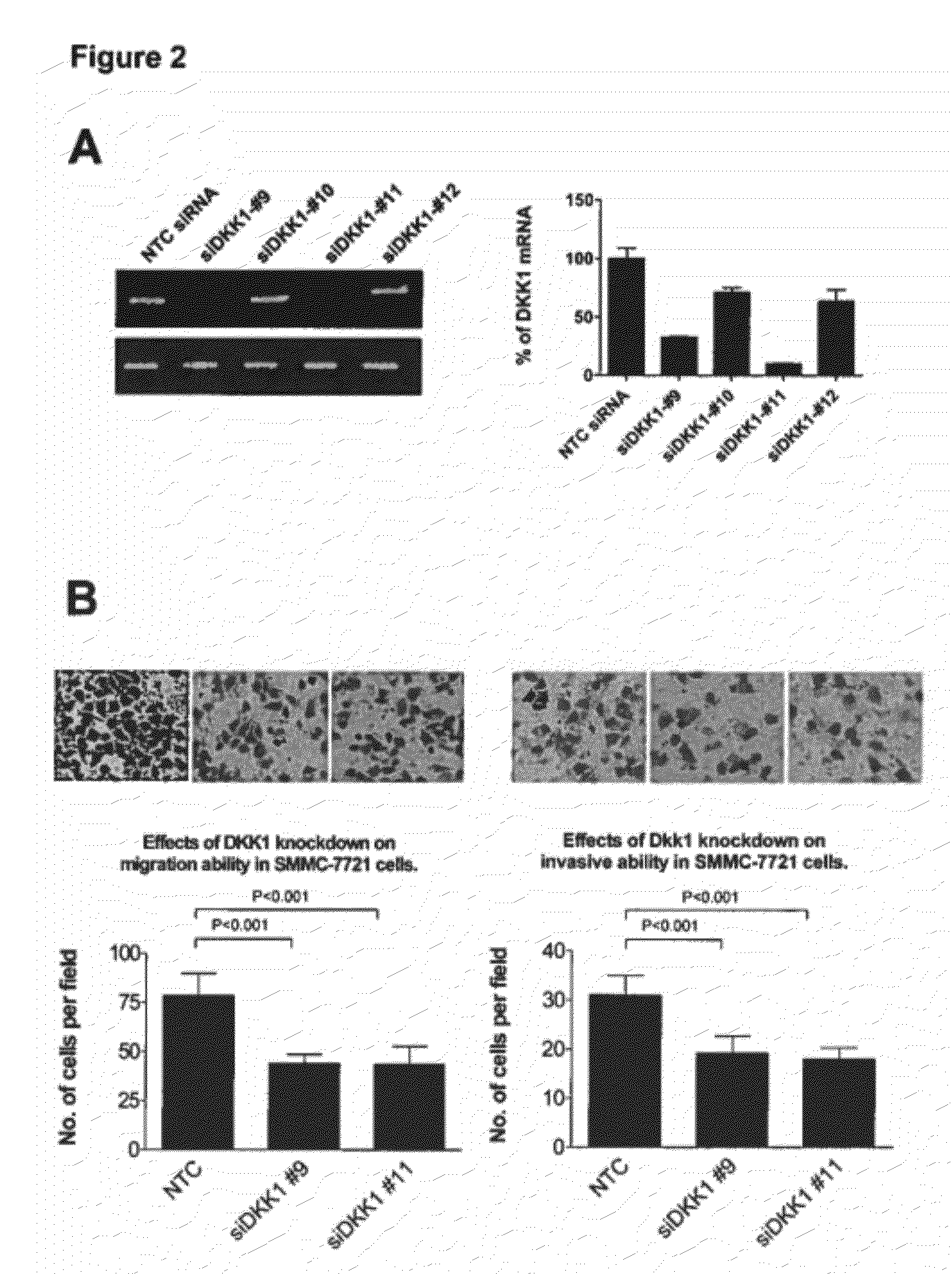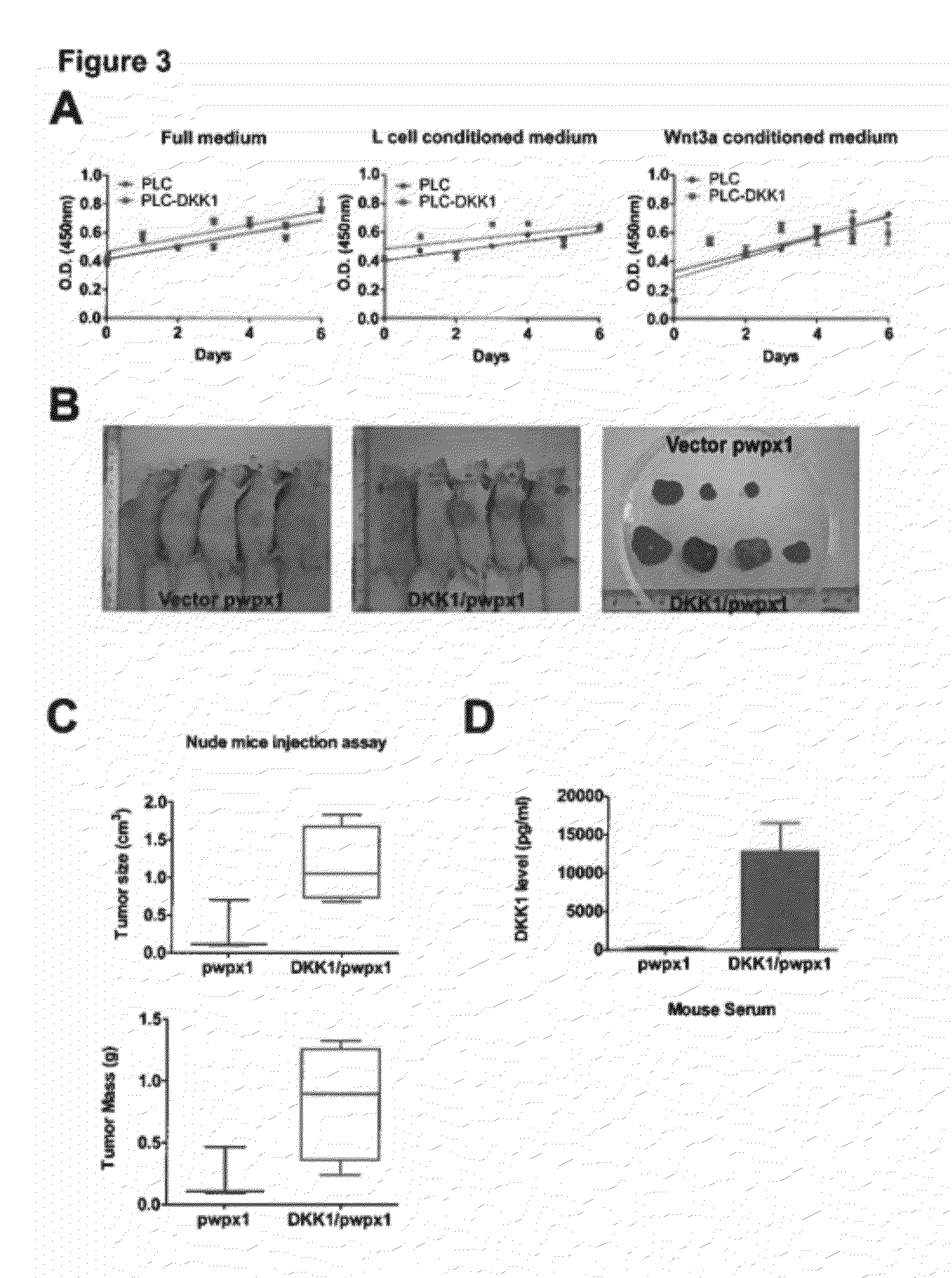Use of Anti-DKK-1 Monoclonal Antibodies for the Treatment of Liver Cancer
a monoclonal antibody and liver cancer technology, applied in the field of liver cancer treatment, can solve the problems of its controversial functional role in cancer, and achieve the effects of reducing tumor recurrence, preventing tumor metastasis, and suppressing liver cancer progression
- Summary
- Abstract
- Description
- Claims
- Application Information
AI Technical Summary
Benefits of technology
Problems solved by technology
Method used
Image
Examples
example 1
Effect of Anti-DKK1 Monoclonal Antibody on Tumor Cell Migration In Vitro
[0046]Cell migration assay was performed using transwell inserts with polycarbonate membranes of 8.0-μm pore size (Corning Inc., NY). In brief, 1×105 cells in serum-free medium were seeded onto the upper chamber. Culture medium containing 10% FBS was used as a chemoattractant in the lower chamber. Anti-DKK1 monoclonal antibody (40 μg / ml) was added into both the upper chamber and lower chamber of the transwells. Cells were then incubated in a humidified incubator at 37° C. for 12 h. Migrated cells on the lower surface of the membrane were then fixed with methanol, stained with crystal violet, photographed and counted in 5 random fields. Each experiment was performed thrice. The data showed that anti-DKK1 monoclonal antibody can suppress the cell migration of HCC cells (FIGS. 9A&B). Another DKK1 antibody from a different source was used for the same assay. We showed that it also inhibited cell migration of SMMC-77...
example 2
Effect of Anti-DKK1 Monoclonal Antibody on Tumor Growth In Vivo
[0047]To assess the suppressive effect of anti-DKK1 monoclonal antibody on the growth of HCC tumor, HCC cells with high level of DKK1 such as SMMC-7721 were trypsinized and resuspended in phosphate-buffered saline. Cells (1×106) were injected subcutaneously into the flank of 6-week-old male immune-deficient mice using a 25-gauge needle (n=5 for each group of experiments). The mice were divided randomly into 3 groups of five mice each. Mice were then injected with either anti-DKK1 antibodies or control IgG (200 μg per mouse) by intraperitoneal injection. The injection procedure was done as thrice a week with a total of 8 injections for each group of mice. Tumor size. was monitored by measuring the largest and smallest diameters of tumor and estimated according to the formula: volume ½×(largest diameter)×(smallest diameter)2. The data showed that anti-DKK1 monoclonal antibody can suppress tumor growth in vivo (FIG. 11).
example 3
The Use of Serum DKK1 Protein in Prognosis of Cancer: Biomarker for Tumor Recurrence
[0048]From the data, it is shown that serum levels of DKK1 have prognostic significance in HCC patients. A higher level of serum DKK1 level significantly correlated with shorter disease-free survival and showed a trend of poorer overall survival. In addition, it was observed that patients with advanced tumor stage tended to have a higher level of DKK1. Therefore, measurement of the DKK1 level by DKK1 ELISA assay predicts tumor recurrence in HCC patients.
PUM
| Property | Measurement | Unit |
|---|---|---|
| Size | aaaaa | aaaaa |
| mass | aaaaa | aaaaa |
| diameters | aaaaa | aaaaa |
Abstract
Description
Claims
Application Information
 Login to View More
Login to View More - R&D
- Intellectual Property
- Life Sciences
- Materials
- Tech Scout
- Unparalleled Data Quality
- Higher Quality Content
- 60% Fewer Hallucinations
Browse by: Latest US Patents, China's latest patents, Technical Efficacy Thesaurus, Application Domain, Technology Topic, Popular Technical Reports.
© 2025 PatSnap. All rights reserved.Legal|Privacy policy|Modern Slavery Act Transparency Statement|Sitemap|About US| Contact US: help@patsnap.com



